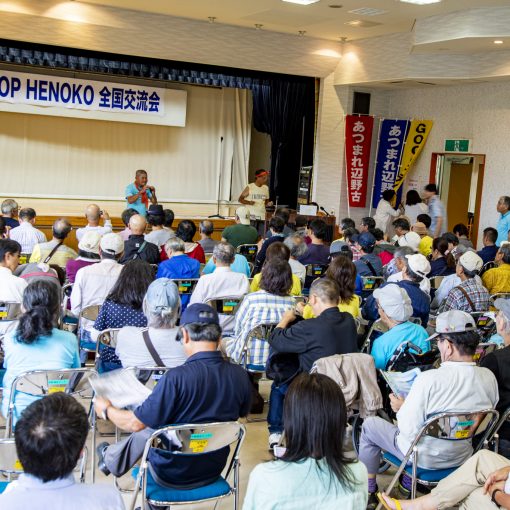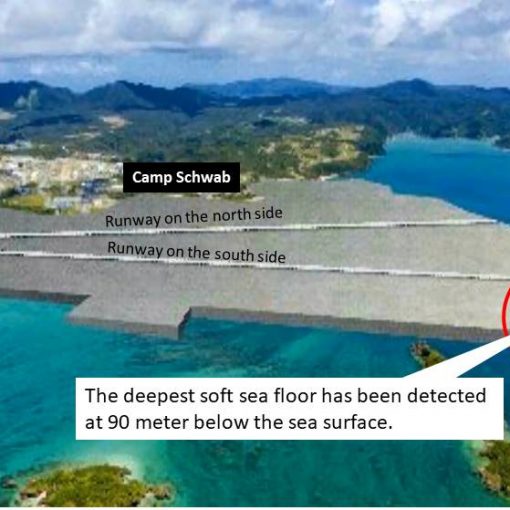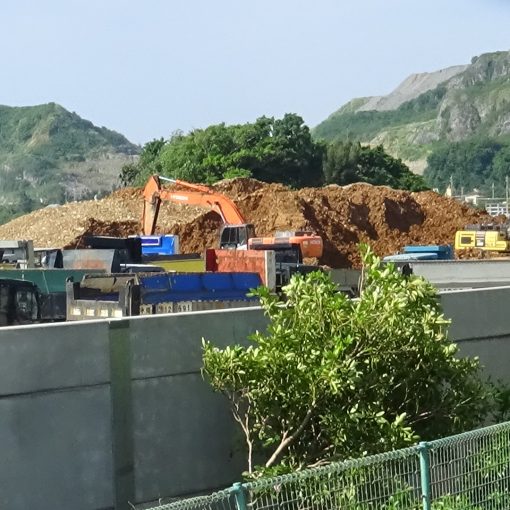Mar 3 (Wed): Day 3 of the Hunger-Strike
Since I joined Mr. Gushiken in the hunger-strike, it’s been only three days, but people around me ask if I’m okay. Doctors come to check my health every day.
I noticed that the number of prefectural government employees receiving flyers seems to have increased. I think they are impressed by the banner that says, “Hunger strike, day 3.”
At 11:00 a.m., we held a press conference with the Foreign Correspondents’ Club of Tokyo through Zoom at the prefectural government press club. Mr. Gushiken explained the government’s sand and soil extraction plan. He pointed out: The remains of 239 U.S. soldiers still lie in the southern part of Okinawa. He also asked if we should use the earth and sand that contain the American soldiers’ remains for the military-base construction?
It seemed that the foreign correspondents had not known of such facts. They raised the voice of surprise. Mr. Gushiken continued that the U.S. is one of the stakeholders in sand extraction in southern Okinawa. The remains of many Koreans who were forcibly brought here also lie in this area. I hope the foreign correspondents will make this fact known to the world.
Ms. Yumiko Hanazaki of Uruma City came to the site with over 2,000 signatures. Having lost her grandmother in the Battle of Okinawa, she said she “couldn’t stand it any longer” when she heard Mr. Gushiken’s appeal and started an online petition. The signatures came from the United States, France, and South Korea. The crowd applauded loudly.
One by one, the bereaved families took the microphone and spoke eagerly about the cruel ground war they had survived and described the situation in which they lost their family members, relatives, and friends. This generation in their 80s and 90s is still alive. When they start talking about the tragic personal experiences at war, there is no end to it. They came to the hunger-strike site because they could not stand the thought of the remains of their relatives, friends, and soldiers whose death they witnessed in front of their eyes may be used to construct the U.S. military base in Henoko. The pain of Uchinanchu, who have been tossed around and pained by the government for many years, erupted again.
The four hunger strikers forgot their hunger and fell asleep, still reeling from the daytime excitement.
Mar 4 (Thu): Day 4
Everyone at the Diet knows about the hunger strike. When asked by reporters on Mar 3, Defense Minister Kishi and Chief Cabinet Secretary Kato gave terrible answers. “We will make a contract with a mining company to extract earth and sand with consideration for the remains,” and “We will give a visual search for the remains.” A mining company replied, “We scrape off the topsoil that contains the remains and use the underneath limestone for reclamation. We will return the scraped-off topsoil to where it was and plant cherry trees and fruit trees.”
Mr. Gushiken angrily and repeatedly explained in response to such comments from the government and mining company. The government should be responsible for collecting the remains of the war dead. Consigning it to a contractor is an abdication of responsibility. Besides, according to Mr. Gushiken, “weathered bones are difficult to distinguish from pieces of limestone, and there is no way a contractor can do it.” He added, “If we use a jumbo machine to scrape off the topsoil, it surely will include the remains. I don’t want that to happen. It is easier to identify the person by digging up the remains without disturbing the place. Besides,206 pieces of bones constitute the human body, and it is impossible to find all of them. Sometimes the remains are found in cracks of the limestone and fallen under the topsoil,” said Mr. Gushiken. His explanation is relatively straightforward and persuasive. He has been crawling on the ground for 38 years, looking for the remains. I hope that the opposition party members will impress on this point and force the government to abandon its plan to collect sand and soil from the southern part of Okinawa Island.
On this day also, many people came and signed the petition. Some of them collected more than 600 signatures online. The plaza in front of the prefectural office was always bustling with hundreds of people. We set up a new banner facing the prefectural office. “To use the soil of southern Okinawa for the base construction is NOT a political matter, but IS the matter of Humanity!”
At 10:30 p.m., heavy rain and gusty winds awoke the hunger strikers. The tent was about to be blown down. Although we were hungry and felt weak, we had to cling to the poles to support the tents. The pillars bent, and the rain flooded one-third of the sleeping area. We were stunned for a while. However, after repairing the tent at about 11:30 p.m., we said to ourselves, “It’s going to be a long night. We have no choice but to sleep.” We all crawled into our damp sleeping bags.



Number of dump trucks to date and percentage against the total
The estimation calculated on the basis of the number of ruckloads serves only as a reference.
Number of dump trucks which made delivery from December 2018 to the end of December 2020 302,705(3.746%)
| 6(Wed) | 8(Thu) | 9(Fri) | 10(Sat) | 11(Mon) | 12(Tue) | |
| Awa | 662(3) | 925(3) | 918(4) | 918(4) | ||
| Shiokawa | 0 | 706(5) | 711(5) | 711(5) |
| Number of dump trucks ※ |
Weightt of earth/sand
※① |
Converted to volume
※② |
Volume per Total
※③ |
| 351,385 | 1,756,925 t | 878,463㎥ | 4.349 % |
※ Cumulative since Dec. 1, 2019
※① Calculated by assuming that the average truckload per dump truck would be 5 tons
※② Calculated by assuming that a specific weight of soil/sand set to be 2
※③ Percentage against 20.200.000m3, the total volume of earth and sand required for the landfill.





